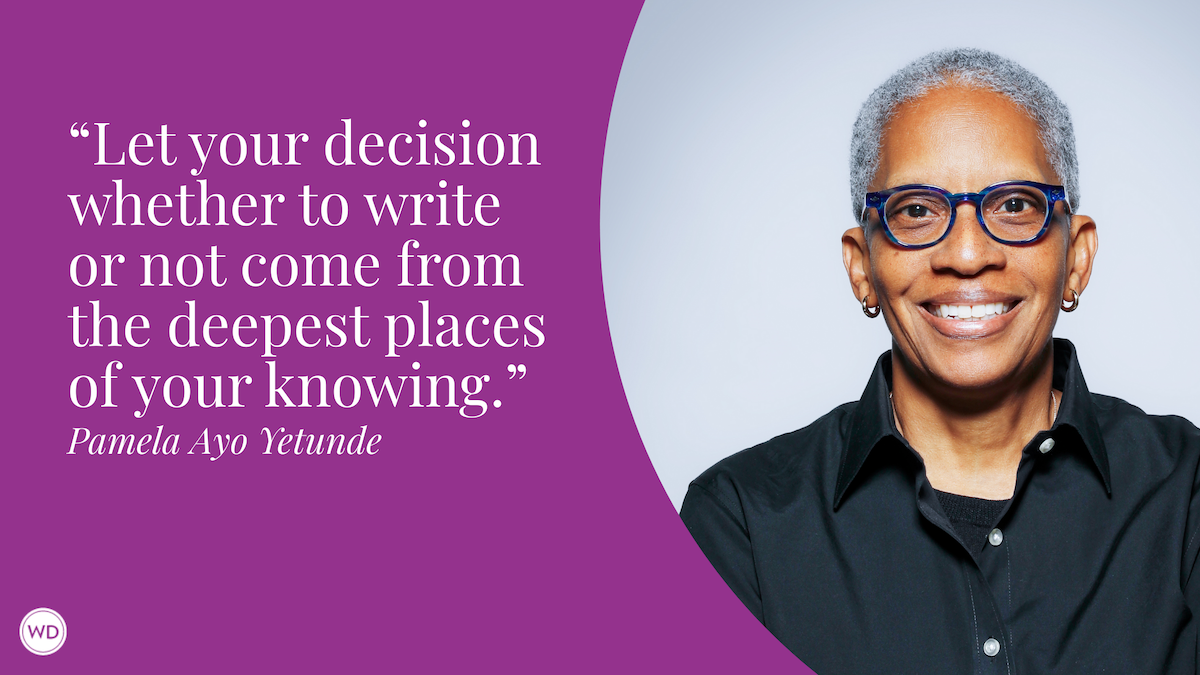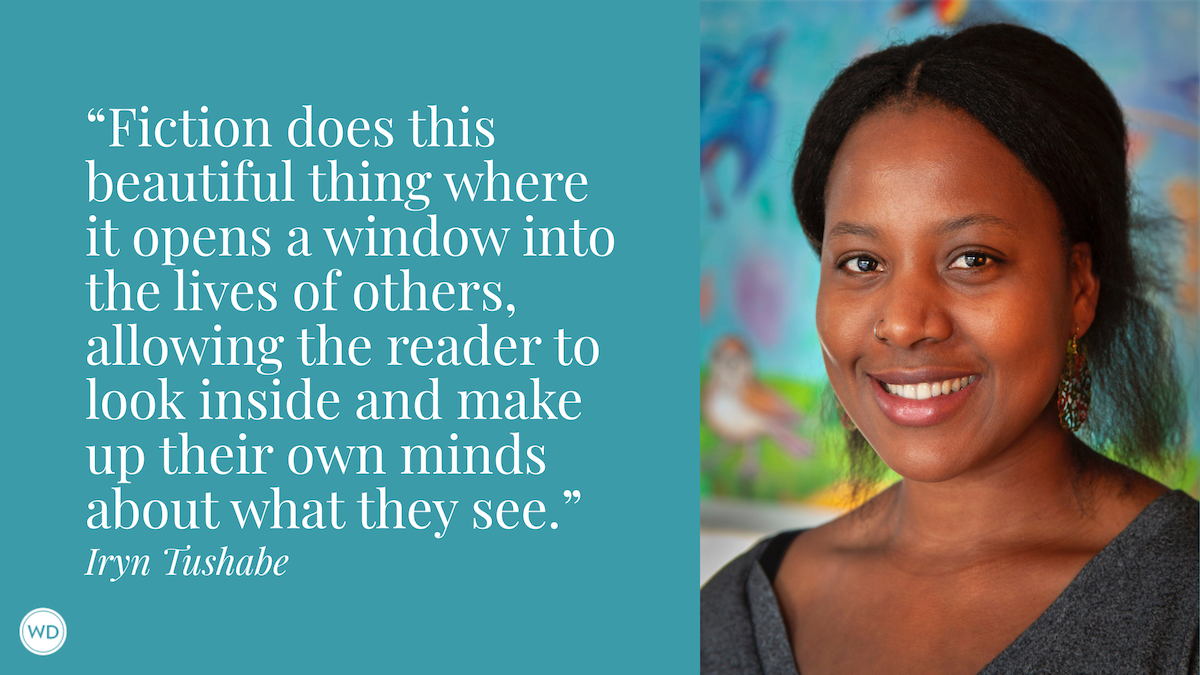Vintage WD: The First Hundred Words Are the Hardest
This article about the importance of the opening paragraph of your fiction writing first appeared in the October 1921 issue of The Writer’s Digest, as it was then known. It was written by Arthur Leeds.
This article about the importance of the opening paragraph of your fiction writing first appeared in the October 1921 issue of The Writer's Digest, as it was then known. It was written by Arthur Leeds.
If you’re familiar with the current “gag,” “The first hundred years are the hardest,” this being a certain humorist’s ironic “crack” at married life, you��ll know what inspired the above title. But, in all seriousness, for the beginner in fiction writing, the first hundred words or so—they may represent the first paragraph, or the first two or three paragraphs—undoubtedly are the hardest, or, at any rate, decidedly the most important in the entire story.
“Rats!” remarks the “wise”—and slangy—beginner. He has read his O. Henry and all the other successful authors, and he knows much better than that. He is thinking of the hundred-and-one smashing, dramatic endings in stories he has enjoyed, and he is absolutely convinced that a bang-up, hit-’em-between-the-eyes “final curtain” is far and away the most important thing in any story, but especially in a short story.
Well, live and learn, profit by experience, collect the rejection slips until you are able to see the light, and know the value of carefully-planned, “punchful” beginnings for your stories!
For more contemporary advice about writing the opening paragraph, check out this article by Fred White from the January 2018 issue of WD.
Why—on the “first nights” of certain plays—do we see this or that well-known dramatic critic getting up and leaving the theater after sitting through just one act, or two acts at the most, and hurrying away to write up a none too complimentary review of the performance? Isn’t the answer obvious? The first half of the first act—which is just about the equivalent to the first page or two of a fiction narrative—has failed to catch and hold his interest; and the dramatist of today who can’t “get” his audience in the first fifteen minutes after the rise of the curtain on Act I, very seldom has a play that will atone for a weak opening scene as the play swings into the second or third act. Consequently, the case-hardened critic is “cold” from the very opening of the play, and—working on the sound-enough theory that what starts off poorly will finish the same way—merely keeps his seat long enough to become familiar with the “work” of the principal players, and will acquire a rough idea of the plot before making a quick get-away preparatory to knocking out his criticism for the morning edition.
And the equally case-hardened fiction editor works—in nine out of ten cases, and almost always in the case of reading the work of the unknown writer—along exactly similar lines. As the editor of one of the so-called “Big Four” magazines once remarked, he doesn’t have to eat a whole boiled egg in order to tell that it is bad. Nor does the trained editor have to read a whole manuscript in order to know that it will be hopelessly uninteresting to his readers.
At a recent meeting of our New York organization, The Writers’ Club, a prominent fiction editor asserted that, whatever his office “readers” might do, he himself seldom found it necessary to read beyond the first page of a story to be able to tell whether he wanted it or not; and, he added, it was very often unnecessary to read more than one or two paragraphs.
Remember, this article is frankly addressed to the beginner in fiction writing; but even some fairly advanced authors fail to recognize, as they should, the supreme importance of the first paragraph or two.
Flora Klickman, who is both an editor and a fiction writer, remarks, in “The Lure of the Pen”—a book which is avowedly “aimed” at “would-be authors”:
“Have you ever read a story that opened, ‘It was a glorious day in June,’ followed by a page of blue sky, balmy breezes, humming bees, not a leaf stirred, and scent of roses heavy in the air? Of course you have. We all have. That glorious day in June is one of the most precious perennials of the story-writer’s stock-in-trade.”
Naturally, the untrained writer follows the line of least resistance, and the “glorious day in June” or “the sun, slowly sinking in the west,” is the inevitable result. But study the work of the experienced writer; even when, for good and sufficient reasons, he deems it advisable to devote his first paragraph or two to “atmosphere” or “local color,” he manages, and with no extra effort—due to the fact that he is experienced—to “get” his reader even with first few words of description. Take, for example—selecting the first old magazine that I find lying beside my desk—the opening two paragraphs of Achmed Abdullah’s short story, “Light,” in the All-Story for May 18, 1918. There are just 112 words:
“Beneath the sooty velvet of the New York night, Tompkins Square was a blotch of lonely, mean sadness.
“No light loungers there waiting for a bluecoat’s hickory to tickle their thin, patched soles; no wizened news vendor spreading the remnants of his printed wares about him and figuring out the difference between gain on papers sold and discount on those returned unsold; no Greek hawker considering the advisability of beating the high cost of living by supping on those figs which he had not been able to sell because of their antiquity; no maudlin drunk mistaking the blur in his whisky-soaked brain for the happy twilight of the foggy green isle.”
It is an “atmosphere” opening; but it is also an opening that compels the reader to go on. Captain Abdullah can do it; Fannie Hurst can do it; any trained writer can do it. But let the novice beware until he has learned the trick—and until his name means enough to the editor to let that autocrat of the magazine office know what will follow will be well worthy of his close attention.
The first thing to remember is that even the experienced author of today, and even when he is writing a long story must get and hold the reader’s attention from the first paragraph. I have as complete files of Harper’s, Century, Atlantic Monthly, Scribner’s (Magazine—and even the old Scribner’s Monthly, which in 1881 was sold to the Century Company and became the present Century Magazine) as are to be found in the larger public libraries; and I take a great interest in going over the old short stories and serials, many of them by writers who, famous in their day, are now remembered by only a few of the older fiction readers. Gone are the leisurely openings, the long-drawn-out descriptive paragraphs that our fathers and mothers stood for (slang is a handy mode of expression, eh, what?). We have just as good writing, and just as good writers today, but the style is oh! so different. And in the Rome of present-day literature, we—you, I, all of us—must do as the Romans do or be left at the post. And you can’t be left at the post and keep up with the slowly-descending high-cost of living. Not to speak of getting ahead in the game, which is what really should spur you on, all pecuniary considerations left aside.
So let’s get ahead with our study of the attention-getting opening.
One thing must be avoided—and the beginner, in a wild scramble to outdo the editor, may easily overlook this point: You cannot afford merely to start off with what may be a jaded-reader-proof beginning, keep up the paced for a page or two, and then allow your yarn to “peter out.” You’ve run up against that sort of thing in the movies, no doubt. The first couple of hundred feet or so is all swift-moving, interesting action; then we get several hundred feet of close-ups of the star in various poses, beautiful “locations” or “sets” that delight the eye but do absolutely nothing toward making the plot move; and the result is about the same as the play with the dull opening scene that drove away the dramatic critic.
Nor can you—this second is a deadly sin!—afford to write an opening paragraph or two which promise a plot development or a situation which never comes to pass, merely because you are determined to hit the reader between the eyes at the very beginning. No special example is necessary in connection with the warning against the first kind of opening; you know what I mean, and common sense is your only guide. In connection with the second offense against the reader, it may be said that very few trained writers are ever guilty of it, and when you do run across an example of it, you almost feel that a printer’s error is responsible for the “false lead.” Nevertheless, I have never quite forgiven the celebrated French writer of detective-mystery stories, Albert Boissière, for one misleading word in the first paragraph of his really remarkable novel, “The Missing Finger” (translated by Mary J. Safford; Dodd, Mead and Company, 1911):
“I was born at the la Varenne-Saint-Hilaire, on the 17th of June of I don’t know what year. It was on a 17th of a month I no longer remember that the civil court pronounced the divorce between Maxime Aubry, artist, and Pauline Mutel, his wife. It was again upon a 17th, the 17th of October, 1907, that I was found murdered by an unknown hand, in the city of Dieppe, at the end of the Quai Henry IV. And once more, by a providential chance, it was on the 17th of last month that I again gave my name to Pauline Mutel, my divorced wife!”
Now, here is a bang-up opening paragraph, and no error! Those who have read Harriet Prescott Spofford’s “The Amber Gods,” Conan Doyle’s “How It Happened,” Percival Wilde’s “Dawn,” or even Captain Abdullah’s “Light,” the opening of which I have quoted, will have a good idea of the type of plot I was led to expect that would be unfolded. But it wasn’t! The narrator of the story was not murdered in the stable on the wharf. It is a misleading statement; and, unless the printer erred, as I have intimated, the only explanations possible are either that the author intentionally put a punch in his first paragraph that was misleading, in order to get the reader’s interest from the very first, or he finished the story, or developed his plot along totally different lines from those upon which he started out.
Apart from this objection—and incidentally—read that story if you possibly can get hold of it! If anyone can write a better mystery yarn, a more fascinating story of dual identity, he is a blown-in-the-bottle genius, and thousands of readers will hail him as such!
But you see the point; don’t mislead your reader under any consideration, and above all, don’t mislead him merely to plant a wallop in your opening paragraph—or the editors (you’ll probably never have readers for that story, if you do) will call you many things other than “genius.”
But if you can get a strangle-hold on the reader’s interest by making some extraordinary statement in your opening paragraph—a statement that you can follow up with a logical and convincing explanation—never miss such a bet!With the determination to do just that, I opened a detective-mystery novelette thus:
“An odd thing has just happened. I have been tried and condemned to die for the murder of Richard Middleton. I am Richard Middleton.”
Extraordinary as the statement may be, in the reading, the development of the plot “made good” the startling opening.
We have gotten away from the old-fashioned allusions to various dangers and misadventures which the writers of a generation or so ago threw out to enlist the reader’s interest in what was to follow. Not only in the beginnings, but all through many of the stories of yesterday, we meet with these interest-soliciting “leads.” But, occasionally, today, an author will start out by forecasting the various things which his hero is about to endure or be confronted with, and when he is such a writer as William Johnston, the author of “The Yellow Letter,” “The House of Whispers,” and “The Apartment Next Door,” he gets away with it. Mr. Johnston’s opening paragraph to his “The Yellow Letter” follows:
“They say that coming events cast their shadows before them, but certainly I had no intimation, when I left my office on the afternoon of April 12, of the maelstrom of mystery and tragedy into which I was about to plunge. There was anxiety in my mind, it is true, but only such as comes to every young man who finds himself for the first time deeply in love. There was no portent of evil, no foreshadowing of the terrible chain of mysteries that all but destroyed my belief in my fellow men and left its mark so deep upon my memory that I do not believe time ever can wholly efface its effects.”
And his second short paragraph runs:
“Even now I shudder at the sight of yellow. A scrap of yellow paper always recalls—and I fear always will recall vivid—the painful events of the last few weeks.”
The story that follows fully justifies Mr. Johnston’s use of what may be called the premonitory opening. Like every other opening, it is the right kind when you know how to use it—and follow it up.
Edgar Wallace—in what I consider the cleverest of the many mystery tales he has written—opens his “Number Six and the Borgia,” in the December 7th, 1920, Popular, in this way:
“The most mysterious and baffling thing about Caesar Valentine was to discover the reason for his mystery. It was a mystery which belonged to the category of elusive though, the name that is on the tip of your tongue, the fact that is familiar, yet defies remembrance.
“When the international police conference held its yearly meeting in 19— in Geneva, and after three strenuous days’ discussion which embraced matters so widely different as the circulation of forged Swedish notes and the philanderings of the Bothnian ambassador—the conference did its best to prevent his assassination, which occurred six months later—the question of Caesar Valentine came up for examination…
“‘Where does he get his money?’ demanded Leary, of Washington. ‘We had him in America for five years, and he did nothing but spend.’
“‘Neither in France nor in America is that a crime,’ smiles Le Comte.
“‘People who have done business with him have had an unfortunate habit of dying suddenly.’ It was Hallett, of the London C.I.B., who put the matter so bluntly, and Leary nodded.
“‘That’s so,’ he said. ‘Providence has been very good to Mr. Valentine. He was in a big wheat deal in Chicago in ’13, and the market went against him. The principal operator was Burgess—John Boyd Burgess. He had a grudge against Valentine, and would have ruined him. One morning Burgess was discovered dead at the bottom of an elevator shaft in his hotel. He had dropped nineteen floor.’”
I have quoted this much concretely to show how an interest-arousing opening paragraph can be instantly followed up by an author who knows what he is going to say—knows his plot from beginning to end, in its larger details, at least—before starting to write. Dr. Frank Crane, at a recent meeting of The Writers’ Club, remarked that in his opinion one of the chief fallacies of writing was the belief that you must know what you have to say before starting to write. Dr. Crane, however, has written very little, if any, fiction; besides which, what he meant to imply, I am sure, is that you cannot turn out artistic work by sticking too closely to a preconceived idea of what you will say on a given subject. But Dr. Crane knows—as every young writer should learn to know—that there must be a fairly well-developed plot outline, or skeleton plot, in an author’s mind before he even writes his opening paragraph, if the result is to be anything but an imperfectly pieced-together narrative. And you may be equally sure that Mr. Clarence Budington Kelland, who, speaking at another meeting of the same club, declared that he seldom knew what his characters were going to do when he started out to write a new story, always has a roughly outlined idea of his complete story before he sets his opening paragraph on paper.
Certain magazines, including, for example The Black Mask, are especially insistent upon the instant engaging of the reader’s attention. “The Black Mask buys only detective and mystery stories,” read the market report in a past issue of THE WRITER’S DIGEST. “They must be novel in plot and very rapid in action. Many manuscripts are rejected because they begin too slowly. There must be action in the very first paragraph.” And it may be said that the writer will make no mistake in applying the rule, in a general way, to any story, no matter at what magazine it is “aimed.”
The very short story almost always demands a “rapid” opening. I commenced “The Carbon Copy” (Black Cat, April, 1916), reprinted in the March, 1920 issue, thus:
“No, Carson—for God’s sake—not yet! Not until I’ve told you something! It means the chair for you, almost certainly, if you do! I tell you man, you’re as good as sentenced for my murder the moment you press that trigger!”
And the story ended as follows:
“He (Carson) bent over the dead man and snatched the envelope from the clutching hand. It contained a thin sheet of paper—it was plainly the carbon copy of a typed letter—and it read thus:
“‘To Police Commissioner Hendry.
“‘Sir: —The writer, James Foster Stillman, has only one enemy who hates him enough to wish to take his life. He has good reason to believe that that enemy—whose name, together with information regarding the position he now holds in the South American business world, will be found in the enclosed envelope—will attempt to kill him some time during the next two weeks. Accompanying this man’s name and address will be found an outline of the circumstances which, the writer believes, will cause his enemy to attempt his life, from motives of revenge. It is earnestly requested that the enclosed letter shall not be opened unless the death of the writer is brought about in such a manner as to point indisputably to murder.
“JAMES F. STILLMAN.’”
Incidentally—in view of the fact that in so short a story I was extremely careful to cut out every unnecessary word—and it can be understood that the story suffered not a little when, in the reprinting of it, someone connected with that now defunct magazine in which it appeared cut down from 900 to about 650 words.
But, in conclusion, as regards story openings, and first paragraphs in particular, the beginner’s best guide is the magazine for which he aims to write. The publisher’s printing bill for rejection slips would be reduced one-half if all authors would follow the advice so often given thoroughly to study each and every magazine they are trying to “make” before submitting a single manuscript.
Have you always wanted to be a writer? Don't let doubt or fear get the best of you—take a chance and learn how to start writing a book, novel, short story, memoir, or essay. WD University's Getting Started in Writing will help you discover your voice, learn the basics of grammar, and examine the different types of writing. Register today!
About Amy Jones
Amy Jones is the Editor-in-Chief of Writer’s Digest and was the managing content director for WD Books. She is the editor of the Novel and Short Story Writer's Market and Children's Writer's and Illustrator's Market. Prior to joining the WD team, Amy was the managing editor for North Light Books and IMPACT Books. Like most WD staffers, Amy is a voracious reader and has a particular interest in literary fiction, historical fiction, steamy romance, and page-turning mysteries. When she’s not reading, Amy can be found daydreaming about Italy or volunteering at her local no-kill cat shelter. Find Amy on Twitter @AmyMJones_5.








